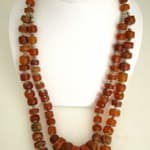Amber and Faience Bead Necklace, 900 BCE - 1200 CE
Amber, Faience
SB.1366
Necklace composed of antique amber beads from the Iron Age through the Crusader period and antique Egyptian faience beads from the Middle and New Kingdoms. Amber, the fossilized resin of...
Necklace composed of antique amber beads from the Iron Age through the Crusader period and antique Egyptian faience beads from the Middle and New Kingdoms.
Amber, the fossilized resin of extinct trees, is one of the oldest gems known to man. Amulets made from it have been found in tombs dating from the Stone Age. Of rich color, its electrical properties made it magic to primitive man and this fascination has continued to the present day. Widespread trade in amber began over 9,000 years ago, when it traveled from the Baltic region to the palaces and cities of the ancient Mediterranean, such as Knossos and Mycenae. It was believed in Antiquity-- as now-- that amber could cure numerous ailments and avert evil or prevent witchcraft. Ancient myths ascribed its origins to the rays of the setting sun, cooled in the ocean; to the tears of rare birds; or to the urine of the lynx. Homer makes mention of amber in the Odyssey. In prehistoric times, the resin oozing from trees sometimes encased insects and other specimens of natural life. These inclusions are highly prized today. Amber varies in color from pale yellow, to rich honey brown, to deep orange to red. Soothing to the touch as well as to the eye, it is still one of the most popular gems after the passage of millennia.
Amber, the fossilized resin of extinct trees, is one of the oldest gems known to man. Amulets made from it have been found in tombs dating from the Stone Age. Of rich color, its electrical properties made it magic to primitive man and this fascination has continued to the present day. Widespread trade in amber began over 9,000 years ago, when it traveled from the Baltic region to the palaces and cities of the ancient Mediterranean, such as Knossos and Mycenae. It was believed in Antiquity-- as now-- that amber could cure numerous ailments and avert evil or prevent witchcraft. Ancient myths ascribed its origins to the rays of the setting sun, cooled in the ocean; to the tears of rare birds; or to the urine of the lynx. Homer makes mention of amber in the Odyssey. In prehistoric times, the resin oozing from trees sometimes encased insects and other specimens of natural life. These inclusions are highly prized today. Amber varies in color from pale yellow, to rich honey brown, to deep orange to red. Soothing to the touch as well as to the eye, it is still one of the most popular gems after the passage of millennia.



